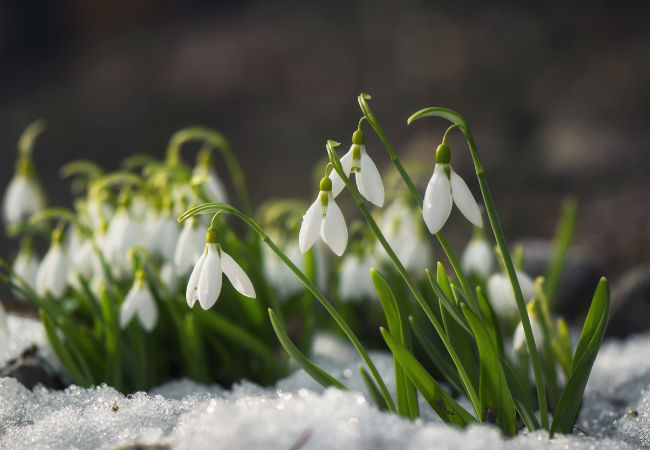

We may earn revenue from the products available on this page and participate in affiliate programs. Learn More ›
Q: I’m dreading the coming winter months because my yard always looks so bare and brown when all the summer blooming plants die or go dormant. Are there any flowers that bloom in the winter? Or, am I stuck with a drab landscape until the temperatures warm up next spring?
A: Great news! Cold weather actually brings out the best in some plants. At the first hint of frost, when most flowering plants wither, the following eight varieties are just getting started. You don’t have to put up with another drab winter. Add a welcome touch of color to your window boxes and flower beds by planting one or more of these colorful winter flowers.
Just note: When choosing plants for your yard, always consult the United States Department of Agriculture’s Plant Hardiness Zone map to determine which ones will grow the best in your specific region.
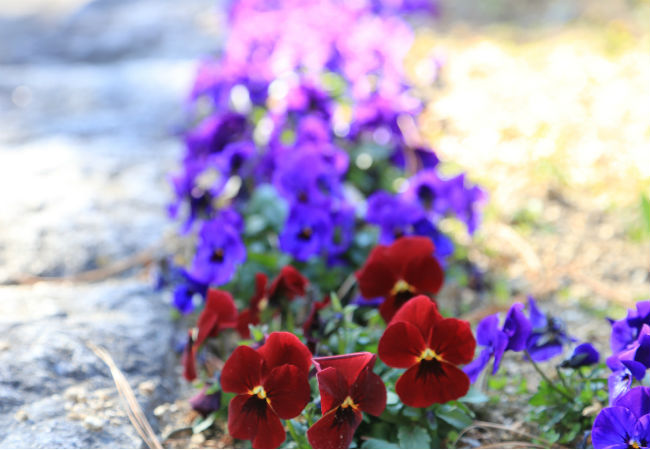
Line your walkways with bright Winter Pansies.
Like their summer-flowering cousins (regular pansies), Winter Pansies (Viola x wittrockiana)—also known as “ice pansies”—will delight homeowners and holiday guests with their colorful 1-inch blossoms borne on low-growing plants. They thrive in zones 6 through 9 and can survive temperatures that dip into the teens. Winter Pansies, which are perennial (meaning they live more than two years), can start blooming as early as December.
Available in a range of yellows, reds, blues, and oranges, these winter flowers are well-suited to window boxes or paired with early spring-blooming bulbs in the flowerbed. They grow well in full sun to full shade and in most types of soils. They can fall prey to garden slugs, however, so if you notice that something has been eating the leaves, apply a commercial slug repellant or sprinkle used coffee grounds around the base of the plant. (You can read up on five other ideas for getting rid of slugs here.)
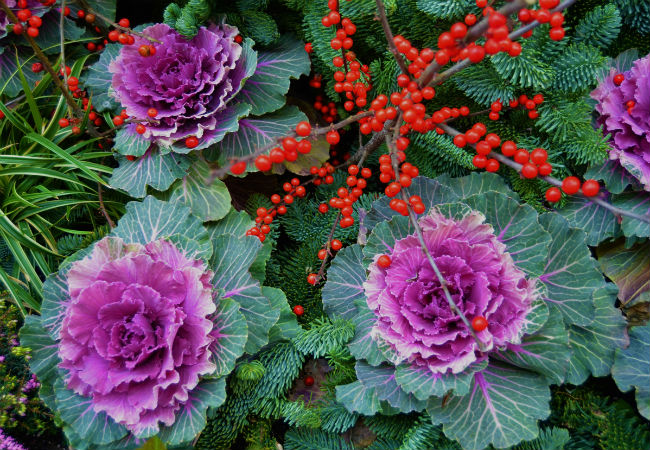
Opt for Ornamental Kale—for it’s looks only (it’s not for eating!)
For striking color on ruffled rosette heads (some exceeding 8 inches in width!), it’s hard to beat Ornamental Kale (Brassica oleracea var. acephala). Related to edible kale, this hybrid loves cold temperatures and develops snow white, brilliant pink, deep rose, and clear violet hues after the first frost arrives. Grown as an annual, Ornamental Kale must be replanted every year, and while it grows in zones 2 through 11, in the warmest zones it will not develop the richest colors.
Ornamental Kale grows best in well-drained soil that’s been enriched by organic matter. It prefers full sun but will tolerate partial shade. The plants reach up to 18 inches in height and look best planted in groups of three or more, where their remarkable colors can create a focal point in the landscape. For the best results, start Ornamental Kale from seed in the flowerbed or in pots in mid-summer. Alternately, purchase plants from your local garden center for transplanting in the fall.
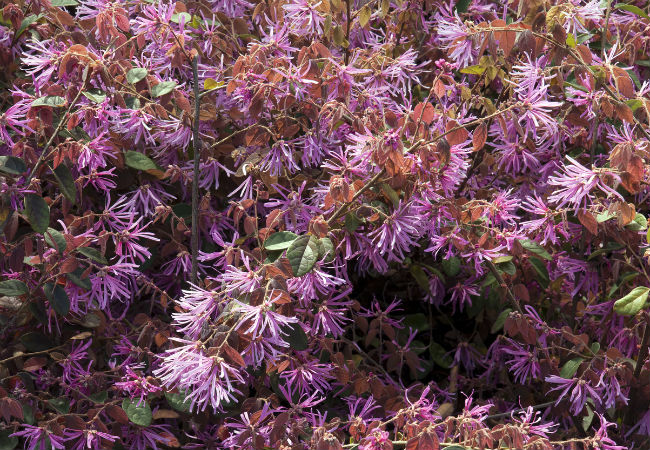
If you can’t wait for spring bulbs to sprout, grow Chinese Fringe Flower.
This winter-blooming evergreen starts flowering as early as February in zones 7 through 10. If left untrimmed, Chinese Fringe Flower (Loropetalum chinense) grows to a height of 5 to 8 feet, with a spread of 3 feet. It makes an excellent single specimen plant, but can also double as a privacy border when the shrubs are planted 2 to 3 feet apart. Its leaves, which remain on the shrub all winter, start out with a hint of burgundy but eventually turn a deep green. Its flowers hang in delicate ruffles, giving the shrub a fringed appearance. Most Chinese Fringe cultivars have white flowers, but one cultivar, Razzleberri, produces dense pinkish-red winter flowers.
Chinese Fringe Flower grows best in partial sun and well-drained soil that’s rich in organic matter, and it will provide years of colorful winter flowers without requiring a lot of care. Chinese Fringe Flower tolerates dry soil and will benefit from a spring feeding of all-purpose fertilizer. Yearly mulching with compost, or other organic mulch, around its base will help it produce lush foliage and abundant flowers.
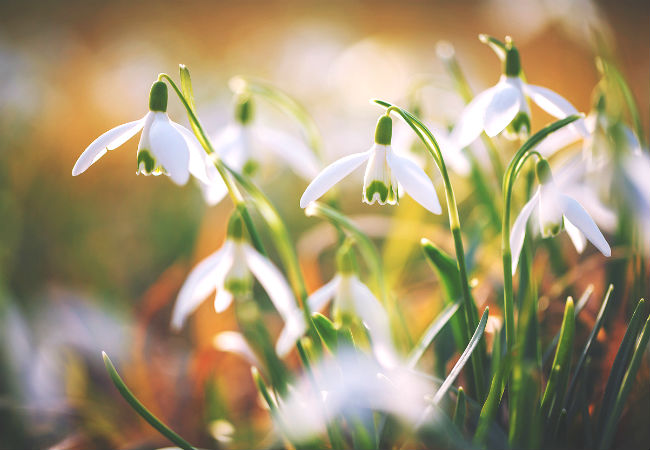
Plant a few Snowdrops in late fall and watch for them to pop up through a blanket of snow.
Snowdrops (Galanthus nivalus) can bloom as early as January in zones 3 through 8. These early bloomers, with their delicate bowed heads and pearl-colored oval petals surrounding a green-tipped center, are the perfect remedy for cabin fever. Snowdrops are low-growers, developing 2- to 3-inch mounds of foliage with blooms that rise only a couple of inches higher.
Plant Snowdrops in late fall in well-drained soil that’s enriched by the addition of compost or peat moss. These winter flowers prefer full shade to partial shade. Each bulb grows into a small mound and spreads a little every year as new bulbs develop underground. Snowdrops are well suited to woodland borders, but they also add a welcoming touch to outdoor pots and raised flowerbeds. They don’t need a lot of fertilizer but may benefit from a light application of all-purpose flower fertilizer in fall.
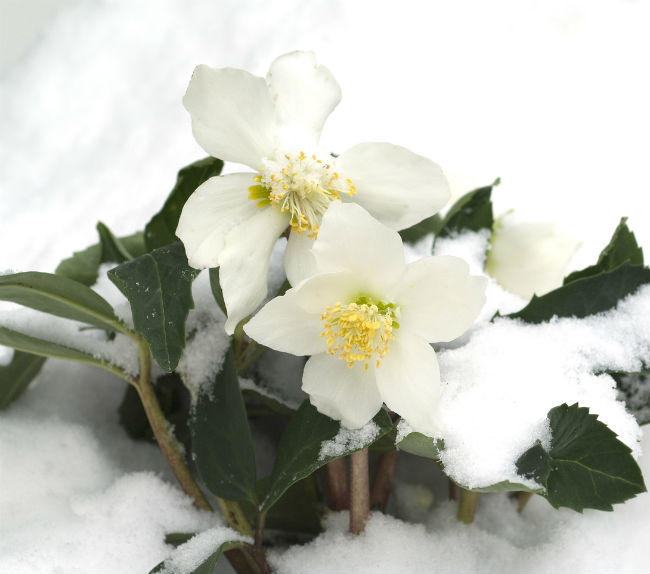
True to its name, Christmas Rose can bloom outdoors as early as late December.
Christmas Rose (Helleborus nigra) is a moderately slow-growing evergreen that reaches a mature height of about 1.5 feet tall and produces snowy white, cup-shaped blooms (up to 3 inches across) that eventually turn a dusty shade of rose. It grows well in zones 3 through 8.
Christmas Rose will bloom winter after winter with very little care, but it does not like to be disturbed—for the best results, plant it and then don’t move it. Select a location with well-drained soil and partial-to-full shade. Plant it under trees and taller shrubs, and you’ll be enjoying its winter flowers long before crocuses emerge from their wintry beds. Christmas Rose may not bloom the first or even the second year it’s planted, so plant these cold-weather beauties knowing that they’ll bloom in a couple of years. Their eye-catching flowers are definitely worth waiting for.
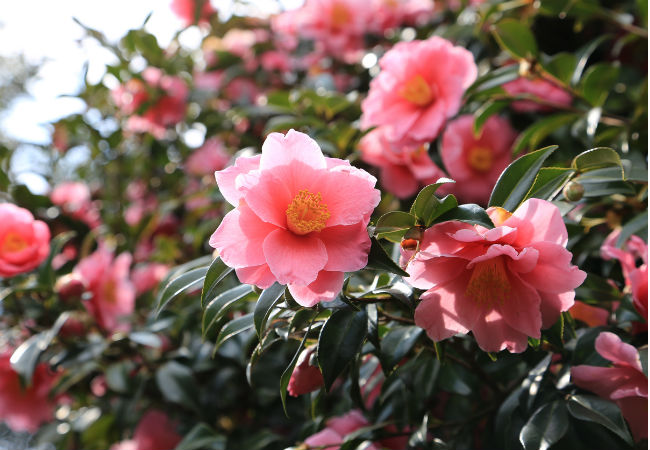
Winter-blooming Camellia is a show-stopper in the landscape.
Sometimes called the “queen of winter flowers,” Winter-blooming Camellia (Camellia japonica) is a favorite in the South. In fact, it’s Alabama’s state flower, but it also does well throughout zones 7 through 10. This evergreen shrub produces large blooms (up to 5 inches across) in blush pink, burgundy, and blood-red hues, providing a colorful contrast against a blanket of snow. Choose from a variety of Camellia cultivars, including “Bob Hope,” “Australis,” and “Pink Icicle,” all of which provide brightly colored blossoms in the dead of winter.
Winter-blooming Camellia does best in full-shade to partial-shade and requires protection from scorching sun and strong winds. Depending on the cultivar, winter-blooming camellia will reach a height of 4 to 10 feet, and a spread of 4 to 8 feet, making it well-suited to shady borders. Plant Winter-blooming Camellia on the north side of a house or a tall fence, or under a shade tree. This flowering shrub requires little maintenance once established.
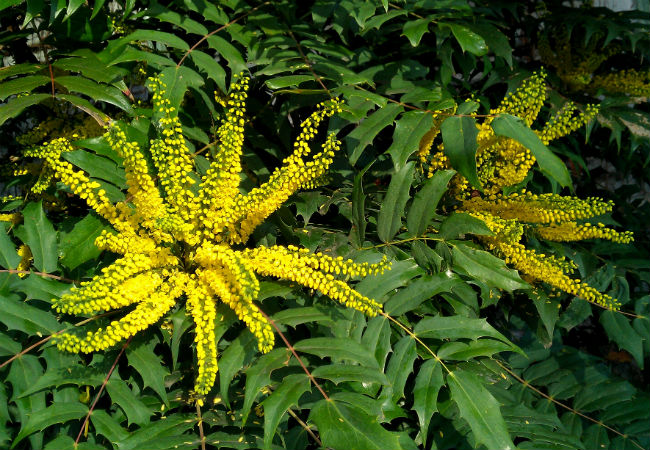
Winter Sun Mahonia starts blooming in December!
Also known as “Oregon Grapeholly,” Winter Sun Mahonia, (Mahonia x media), is a glossy-leafed evergreen with thick leathery leaves and bright yellow flower spikes that appear in vertical sprays. It grows well in zones 7 through 9, reaching a mature height of 6 to 8 feet with a spread of 4 to 5 feet. Its striking winter flowers are followed in spring by bright blue fruits that attract a variety of songbirds.
Plant Winter Sun Mahonia where it will receive no more than 2 to 3 hours of morning sunlight. It loves a shady location and prefers rich, well-drained soil. This evergreen’s freeform arcing branches give it a woodland appeal, making it well-suited for planting beneath taller trees in a casual wooded border. It self-sows and can spread to other areas of the landscape so give it plenty of space.
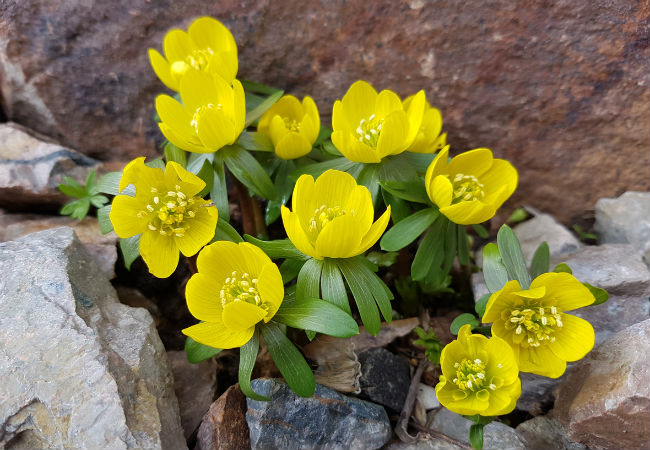
For a splash of sunny color when everything else is drab and gray, add Winter Aconite to your landscape.
Feathery green foliage and bright yellow flowers emerge in early February to mid-March, making Winter Aconite (Eranthis hyemalis) one of the earliest bloomers in zones 3 through 8. The entire plant reaches no more than 6 inches high, making it a good choice for rock gardens, pathways, and around the bases of trees and shrubs.
Winter Aconite grows from small bulbs planted in mid-to-late fall after the soil has cooled. This easy-care plant thrives in most soil types and withstands drought conditions. It doesn’t tolerate transplanting, however, so choose its location carefully, and it will provide you with years of delightful yellow winter flowers.
